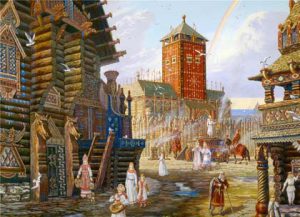
The Slavonic shrine on the island of Rügen
 17. 11. 2016
17. 11. 2016

The history of the Elbe Slavs was probably the saddest story in the history of the Slavic tribes, their ending was very similar to the tragic fate of the Baltic Prussians (which you will not read on Wikipedia as being Slavs). Due to their certain isolation, they did not encounter Christianity for a long time, and eventually their persistent resistance became fatal to them. German and other missionaries were followed by repeated crusades, during which looting and murder took place. Blasting colonizers began to push for the Slavs. The result was the disappearance of the language, culture and historical consciousness of this ethnic group in a large area of Central Europe.
Ruegen and Rans
Today, Rügen is a popular tourist destination in Mecklenburg-Western Pomerania. Archaeological finds indicate that there was a Slavic settlement in these places at the beginning of the 7th century, it was a tribe of Rány (Rujanů), which belonged to the Elbe Slavs. According to the oldest surviving records, the West Slavic branch came to the territory of today's Germany in the 6th (some sources state the 4th-5th) centuries AD and settled mainly its eastern part.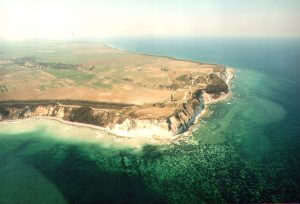
The wounds created a powerful principality at that time, whose spiritual center was the shrine in the fortified settlement of Arkona, the ruler was based in Korenica. The Danish chronicle, Saxo Grammaticus, wrote in the 12th century: "" The city of Arkona lies on top of a high rock and is protected from the north, east and south by cliffs "on the west side it is protected by a rampart, about 20 meters high. In the middle there is a square, which is dominated by a beautiful wooden temple, decorated with artificial carvings on the outside. "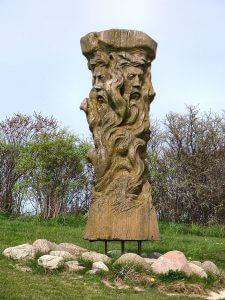
The central object of the church was a life-size statue of Svantovít. Svantovít was the protector of both the Western Slavs (worshiped by several tribes) and the fields, and he was still "in charge" of abundance. He is mentioned in various sources as the god of war and economy. He looked like a man with four faces, a long sword, a bridle, a saddle, and a banner. And like Radegast, he had his sacred white horse. The white man was kept at the sanctuary, only the highest stallion (priest) had the right to ride on it, and according to oral tradition, Svantovít himself went with him at night at night - in the morning they found horses in a stable sweaty and muddy.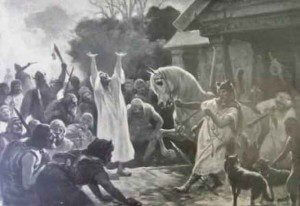
The chronicler described the most important sanctuary of the Elbe Slavs, which was located in the territory of the Rány tribe and was also a fortune-teller. The prophecies concerning the harvest took place through the horn of plenty. The stallion filled it with wine - and here again the words of Saxon Grammatic: "In her right hand she held (a statue) a horn made of various kinds of metal, which the priest, familiar with its ceremonies . Accordingly, they also determined how much grain needed to be set aside. They foretold the success of the expeditions, naval or warlike, and various other intentions, by means of a sacred white horse, which they led through a row of crossed spears, and according to which foot crossed which row they came to the conclusion of the result. If it was negative, they postponed the matter.
Not only the Elbe but also the Baltic Slavs traveled to the sanctuary to honor God and often at the same time for divination. In addition, Svantovít's power was supported by a retinue of three hundred riders and great wealth from the donated gifts and fees. It is therefore not surprising that Svantovít's stallion had a greater say in some matters than the Prince of Rügen.
In addition to agriculture, the Wounds also engaged in trade and seafaring, for which they had excellent conditions. The island of Rügen has not only a convenient location, but also a number of bays suitable for ports. The local Slavs traded mainly food, which in less fertile Scandinavia they exchanged for weapons, jewelry, coins, etc. Local sailors soon became famous and even began to compete with Vikings, especially Danes. Slavic sailors dared to make long journeys to Constantinople, Russia or the Atlantic.
The Rans were part of the Velets (Lutice) union. But he broke down at the beginning of the twelfth century.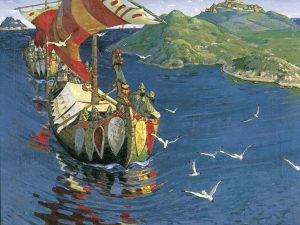
Western Slavs
The blossoming West Slavonic principality in the territory of today's Germany eventually did not withstand the Christian and military pressure from the West, and eventually succumbed to 300's resistance. The places of the Slavic shrines - Retra, Branibor (Brena) and Arkona - fell.
The war conflicts, which continued the Second Crusade against the Slavs in 1147, led to the fall and occupation of the Obodrit principality in the 12s, to the conquest of Rügen and to the occupation of the Stodoran principality. The defeated Slavs were called pagans and lived with this stigma for several more centuries.
After the fall of Branibor in 1157, Rügen became the last independent Slavic territory and at the same time the last island of the Slavic faith in this territory. Arkona was last conquered in 1168 by King Valdemar I of Denmark. The statue of Svantovít was destroyed and burned, and the local Slavs were forcibly baptized. After that, the Principality of Rügen was annexed to Denmark - until the Roman Empire "conquered" this territory through diplomatic channels.
It must be added that not only the crusades themselves were able to subdue the Elbe, but also contributed to the fighting between the Velets and the Obodrites, which were instigated by the surrounding Germanic tribes.
The information available to us today comes mainly from the Slavic Chronicle of the priest Helmold and from the History of the Danes Saxon Grammatic. We do not know much about the religion of the Elbe and Baltic Slavs - the only source (apart from archeology) is the reports of authors who, to put it mildly, were not in favor of the Old Slavic faith. The myths of the Elbe Slavs are not recorded and there is no equivalent of Icelandic Eddic songs or ancient mythology.
The rest of the Elbe Slavs that have survived to the present day are the Lusatian Serbs. Probably also the Kashubians - in their case there are still disputes over whether they belong to the Polabans (today their most famous member is Donald Tusk, although few people know that he is Kashuba). In the last 25 years, Lusatia has, unfortunately, be "lost". In the ancient past, they were helped by John of Luxembourg and especially Charles IV, who protected them and thanks to which they have preserved their language and customs to this day. Unfortunately, Germanization and assimilation are already "rushing" into the abyss. The unification of Germany contributed to this to a large extent - in the GDR, as a minority, they were in a way protected and lived on their territory; after unification, they were scattered to various corners of the country in search of earning opportunities.
The basic sources about the Elbe Slavs are - in addition to the History of the Danes (who were the greatest enemies of the Wounds, although they traded together) and the Slavonic Chronicle of the priest Helmold of Božov (Bosau), there are three other great chronicles that belong to the top works of medieval chronicler history:
- chronicle of the Corby monk Widukinda
- Chronicle of the Inter-Sorbian (Merseburg) Bishop Thietmar
- Chronicle of the Brethren Canon Adam
Finally, a few quotes from these sources:
"However, they preferred to choose war rather than peace, the price-priced freedom of all fools. This kind of people is tough, he can endure strain, he has gotten the most livelier way of life, and that's what we're having a heavy burden of, the Slavs think almost for pleasure. Many days have passed, struggling with alternate happiness, one for glory and for a great and broad empire, others for freedom and the threat of addiction. "
Widukind, monk of the Corvey monastery, in the Three Books of Saxon History, Book II, Chapter 20, the second half of 10. century.
"The Slavs, oppressed by Christian judges more than just, have been persuaded to overthrow the yoke of slavery and defend their freedom with weapons."
Adam, Canon of Bremen, in the Acts of the Bishops of the Hamburg Church, Book II, Chapter 42, second half of the 11th century.
"The Slavs overthrew the yoke of service with an armed hand and, with such stubborn spirit, defended freedom that they would rather die than accept the name of the Christians again and pay tribute to the Saxon dukes. Such a disgrace was prepared by the unfortunate greed of the Saxons, who, when they were still in full force, brought out frequent victories, not acknowledging that war belongs to God and from him is victory. The Slavic tribes were burdened with such rations and fees that a bitter necessity drove them to defy the laws of God and the service to princes. "
Helmold, priest of Bohemia, in the Slavonic chronicle, book I, chapter 25, s. 110-112, the second half of 12. century.
Short Row
We should realize that we are the last Westernest Slavs. In the past, the same procedures were applied to us as to the Elbe Slavs, including the Crusades, we survived, and not just the Crusaders. Perhaps also due to the fact that the Elbe fragmented their forces with their resistance, which were aimed at the Slavs. However, the Germanic tribes once evacuated the area in today's Germany and fled from the Huns, then the Elbe Slavs came to this territory. But the Moravian tribes never "backed up" in front of the Avars, allies of the Huns, and kept their borders!
Links and literature
http://tyras.sweb.cz/polabane/kmeny.htm
http://milasko.blog.cz/rubrika/polabsti-slovane
who knows Miroslav Zelenka, I recommend (others "at your own risk"): http://www.svobodny-vysilac.cz/?p=8932
Alexei Pludek: Ancient Times (1971) - myths and fights of the Elbe Slavs





 1
1